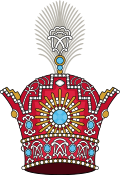

| Part of a series on |
| Imperial, royal, noble, gentry and chivalric ranks in West, Central, South Asia and North Africa |
|---|
 |
King of Kings[n 1] was a ruling title employed primarily by monarchs based in the Middle East and the Indian subcontinent. Commonly associated with Iran (historically known as Persia in the West[8]), especially the Achaemenid and Sasanian Empires, the title was originally introduced during the Middle Assyrian Empire by king Tukulti-Ninurta I (reigned 1233–1197 BC) and was subsequently used in a number of different kingdoms and empires, including the aforementioned Persia, various Hellenic kingdoms, India, Armenia, Georgia, and Ethiopia.
The title is commonly seen as equivalent to that of Emperor, both titles outranking that of king in prestige, stemming from the late antique Roman and Eastern Roman emperors who saw the Shahanshahs of the Sasanian Empire as their equals. The last reigning monarchs to use the title of Shahanshah, those of the Pahlavi dynasty in Iran (1925–1979), also equated the title with "Emperor". The rulers of the Ethiopian Empire used the title of Nəgusä Nägäst (literally "King of Kings"), which was officially translated as "Emperor". Sultan of Sultans is the sultanic equivalent of King of Kings.
In Judaism, Melech Malchei HaMelachim ("the King of Kings of Kings") came to be used as a name of God. "King of Kings" (Ancient Greek: βασιλεὺς τῶν βασιλευόντων, romanized: basileùs ton basileuónton) is also used in reference to Jesus Christ several times in the Bible, notably in the First Epistle to Timothy and twice in the Book of Revelation.
- ^ Handy 1994, p. 112.
- ^ King of kings in Media and Urartu.
- ^ Yücel 2017, pp. 331–344.
- ^ Olbrycht 2009, p. 165.
- ^ Dédéyan, Gérard (2003). Les Arméniens entre Grecs, Musulmans et Croisés: étude sur les pouvoirs arméniens dans le Proche-Orient méditerranéen (1068-1150) (in French). Fundação Calouste Gulbenkian. p. 531.
- ^ Pinkerton 1811, p. 124.
- ^ Dejene 2007, p. 539.
- ^ Yarshater 1989.
Cite error: There are <ref group=n> tags on this page, but the references will not show without a {{reflist|group=n}} template (see the help page).